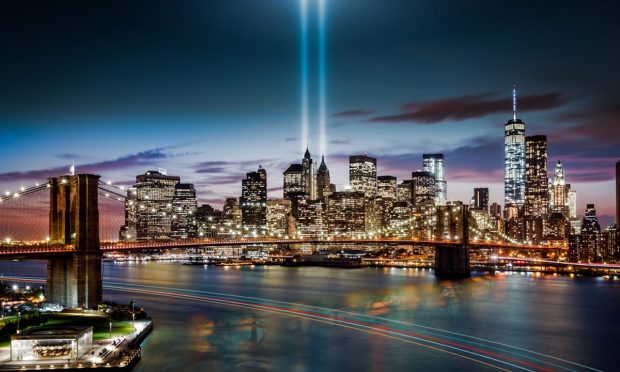Remembering a Day That Changed America — and the World

Where were you on Sept. 11, 2001?
Maybe in school, at the office, away on a business trip, or sitting at home. Ask, and people will tell you. Those who remember living the horrific events of that day can never forget.
On this date exactly 20 years ago, the 9/11 attacks and their aftermath still bring a flood of emotions for those who watched, frozen in place or screaming at TV screens, as the unthinkable unfolded before their eyes. We perceived that life would never be the same again.
It was also a moment of world unity the likes of which has not been seen before, or since. Outpourings of support rang from every corner of the planet. We were as one, however briefly.
Those not yet born or too young to grasp the enormity learned about it in classrooms and on TV, from family and friends. As 9/11 Memorial & Museum President and CEO Alice Greenberg recently tweeted, “For younger Americans, 9/11 is not a memory lived, but history learned.”
“For younger Americans 9/11 is not a memory lived but history learned.” – @alicegreenwald, President and CEO of the 9/11 Memorial & Museum. Learn how you can help: https://t.co/764865PNoS. #NeverForget911 pic.twitter.com/63qLpoRiA5
— 9/11 Memorial & Museum (@Sept11Memorial) September 9, 2021
New York’s World Trade Center is ever-after known to millions as Ground Zero, invoking the sites on which atomic bombs are detonated. Etched in collective memory are images of jetliners slamming into the former Twin Towers, then their unimaginable collapse shortly after impact.
On the site today stands the new World Trade Center complex, anchored by the glittering Freedom Tower, part skyscraper and part working monument to those we lost. At Nasdaq headquarters in Times Square hangs a giant American flag that went to all 50 states. It’s a constant reminder that there is always a future, even after a calamity that feels world-ending.
Though not world-ending, 9/11 was undeniably world-changing.
See also: The 9/11 Memorial & Museum 20 Years Later
The People and the Places
On this day, we remember the first responders. As ordinary people ran away in terror, brave professionals ran toward burning jet fuel and falling debris, climbing smoke-choked stairwells to find survivors. They saved many who were certain to die, but perished in that noble rescue effort — and for years after, illnesses from digging in the WTC rubble claimed even more lives.
We remember the final, heartbreaking phone calls made to loved ones by those who knew they were not going to survive. Nearly 3,000 people did not. Tri-state commuters saw the cars sitting unclaimed in railroad station parking lots long after as a chilling memory of neighbors lost.
Many recognize the company Cantor Fitzgerald, the financial services firm with offices on the 101st and 105th floors of the Twin Towers, which lost 658 employees that morning.
As Cantor Fitzgerald CEO Howard Lutnick told The Wall Street Journal last week, “…this year as I reflect on 20 years, it just doesn’t feel like yesterday anymore. I employ the children of people who were killed that day. Twenty years is as much time since 9/11 as I was at Cantor Fitzgerald before 9/11.” Lutnick’s own brother Gary was among those killed that day.
From that tragedy came the Cantor Fitzgerald Relief Fund, the first of many such funds to follow.
About 300 miles from Manhattan is the tiny borough of Shanksville, Pennsylvania, where today there stands the Flight 93 National Memorial, commemorating the loss of life at this rural crash site.
We’re reminded of Todd Beamer, traveling to San Francisco on business when the jetliner was commandeered as a weapon of mass destruction. Beamer quickly devised a plan to take out the hijackers. Gathering passengers and crew, he said eight fateful words: “Are you guys ready? Okay. Let’s roll.” The passengers and crew prevailed, sacrificing their lives in so doing.
It was later learned that the intended target of Flight 93 was the U.S. Capitol Building.
See also: The Flight 93 National Memorial
Remembrances and Affirmations
Also that morning, Flight 77 departed from Washington Dulles International Airport. It was boarded by five hijackers who quickly took control of the aircraft after takeoff, slamming it into the U.S. Pentagon, killing all 64 people on board and 125 personnel inside the building.
Today, the Pentagon Memorial stands in nearby Arlington, Virginia.
As its website somberly says of those lost, “They were men, women and children. They were mothers and fathers, husbands and wives, sisters and brothers, daughters and sons. They came from all walks of life: administrative assistants, doctors, educators, flight crew members, military leaders, scientists and students. They came from towns and cities, large and small, across the United States and around the world. The youngest was only three years old; the oldest, 71. Despite the differences that distinguish them, these innocent individuals are united through the horrific events that unfolded on one of the darkest days in America’s history.”
Where were you on Sept. 11, 2001? It’s a deeply personal question for millions of people in America, and around the world. For others, it is a historical event rather than an experience.
In the years since those terrible attacks, we’ve learned more of selflessness and the resilience of the human spirit than we thought possible. It’s an affirming notion for a grave remembrance.
